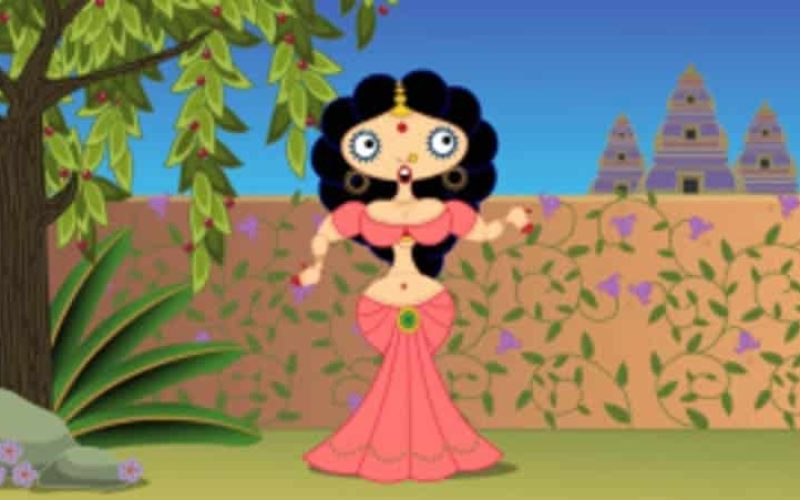Sometimes you watch a movie that’s so creative, emotionally resonant, and unique that you want everyone else to see and experience it too. Sita Sings the Blues, an independent animated film from 2008, is one of those movies.
Written, animated, directed, and edited almost singlehandedly by filmmaker Nina Paley, Sita Sings the Blues blends fantastic animation, great writing, and excellent voice acting; it also provides a funny, sad, and thoughtful look into marriage, heartbreak, and resilience.
This movie will have you singing the blues, laughing up a storm, and caught up in its energetic presentation. Now let’s sit back and enjoy the show.
What is Sita Sings the Blues About?
Sita Sings the Blues follows two temporally distinct but thematically entwined stories: the real-life story of Nina Paley’s failing marriage with her husband Dave and a retelling of the Hindu Sanskrit epic poem the Ramayana.
In modern San Francisco, California, Nina Paley’s husband Dave accepts a six-month contract to work in Trivandrum, India. Though initially happy for him, Nina worries about their marriage when he doesn’t call her for a month. When she moves to India to live with him, her concerns worsen because he shows no interest in physical or emotional intimacy. As their relationship falls apart, she finds solace in the Ramayana, a story about two gods incarnated as human beings who also struggle to make their marriage work.
In ancient Ayodhya, India, Sita and her husband Rama live in exile from Rama’s father’s kingdom. After he sees and falls in love with her, the rakshasa king Ravana kidnaps Sita and demands her to become his wife under threat of death, but she refuses to marry him. After Rama rescues her, Sita proves that she was faithful to him via a trial by fire; he never fully trusts that she did not sleep with Ravana, though, and his doubts prove disastrous to Sita.
Sprinkled throughout the movie are the musings of three shadow puppets, voiced by friends of Paley, who discuss and debate different variations, contradictions, and meanings of the events and characters of The Ramayana, as well as musical interludes where Sita sings various songs by the 1920s and 30s era jazz singer Annette Hanshaw to express her love for Rama and her grief at his cold treatment of her.
What Was the Reception to Sita Sings the Blues?
As of 2024, the top three uploads of the movie have been watched over 1.5 million times and received over 10,000 likes on YouTube. Film critic Roger Ebert called the movie “astonishingly original” and one of the best films of 2009; Hinduism Today writer Lavina Melwani praised the movie as a “kaleidoscope” of different styles and influences that creates “the most amazing, unexpected patterns.”
Many Indian and Hindu viewers have criticized Paley for distorting the Ramayana to mirror her own story of heartbreak and healing. While admiring the movie’s artistry and humor, blogger Vineet Chander said that Paley ignored most of Rama’s positive traits like his heroism, kindness, and wisdom in order to sharply criticize his treatment of Sita. Other critics felt that the movie should instead be called the Sitayana because it shifted the focus of the story from Rama’s adventures and virtues towards Sita’s faithfulness and suffering.
Other Indian writers pushed back against the second criticism, arguing that there is a long tradition among women in India of retelling the Ramayana in a way that emphasizes Sita’s story over Rama’s, much as Sita Sings the Blues does.
Why Should You Watch Sita Sings the Blues?
Sita Sings the Blues is an animated masterpiece. Paley effectively uses multiple animation styles to visually distinguish her personal story from the events of the Ramayana and to set the tone of each scene in the story.
Paley animates herself and Dave in Squigglevision that gives their scenes a modern flair. When retelling the main plot of the Ramayana, she draws the characters like figures in Mughal paintings and animates them with limited lip and limb movements that evoke a classical style. When her three friends discuss the Ramayana, she animates them as Indonesian shadow puppets commenting on the story as characters in the background try to interpret what they describe. Whenever Sita sings an Annette Hanshaw song, Paley depicts her and other characters in lively and brightly colored 2D animation. The movie is a visual treat filled with tons of inventive details to grab your attention on every frame.
Paley masterfully combines direct narration, dialogue, musical interludes, and intertextual commentary to provide various perspectives on and interpretations of the characters and events in both stories. She also balances comedic and tragic moments in the movie to create an emotionally satisfying experience.
Final Thoughts
With its beautiful animation, wonderful humor, heartbreaking moments, and rich storytelling, Sita Sings the Blues will keep you engaged throughout its runtime and remain on your mind long after it’s over. Available for free on YouTube under a Creative Commons Share Alike License, Sita Sings the Blues is well worth your time to watch.
For More Great Content
Total Apex is an all-encompassing content producer. We provide heavily detailed articles every day on entertainment, gaming, sports, and so much more! For more exemplary gaming and entertainment content, read our daily content on these sites: Total Apex Gaming and Total Apex Entertainment.









